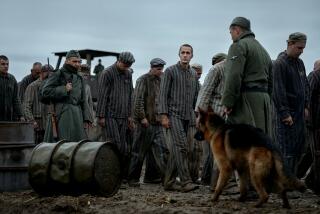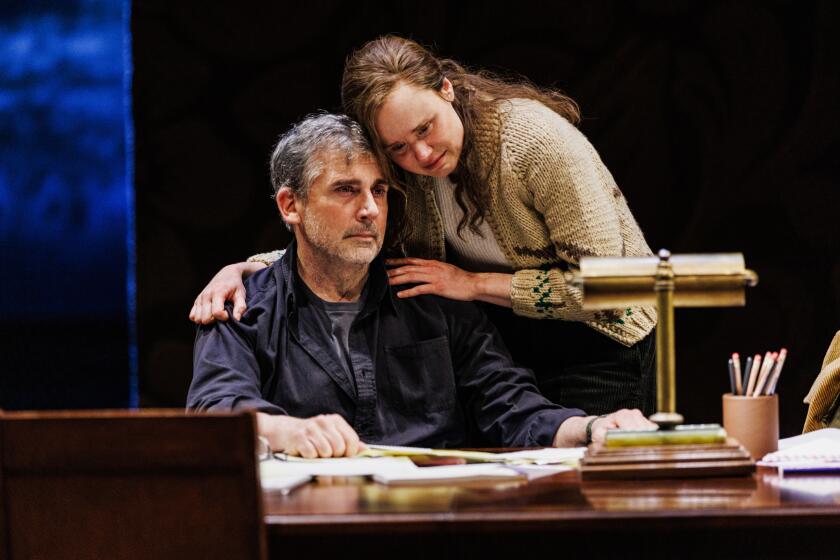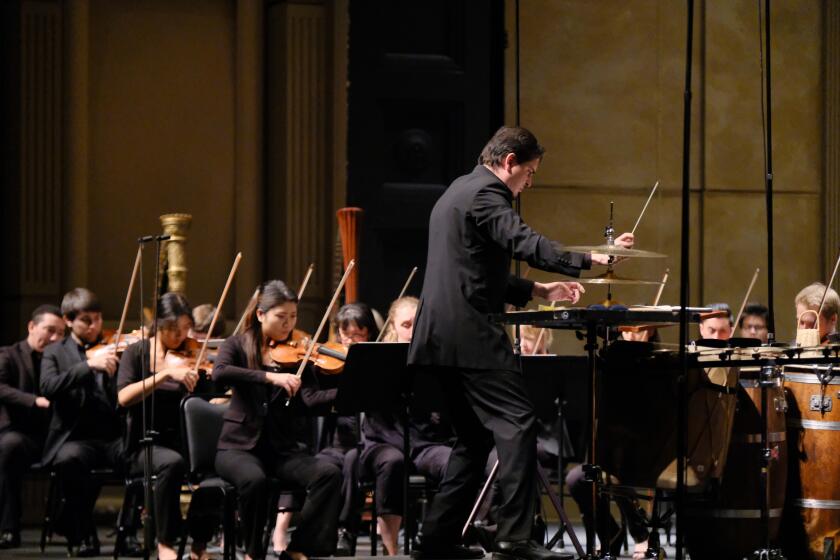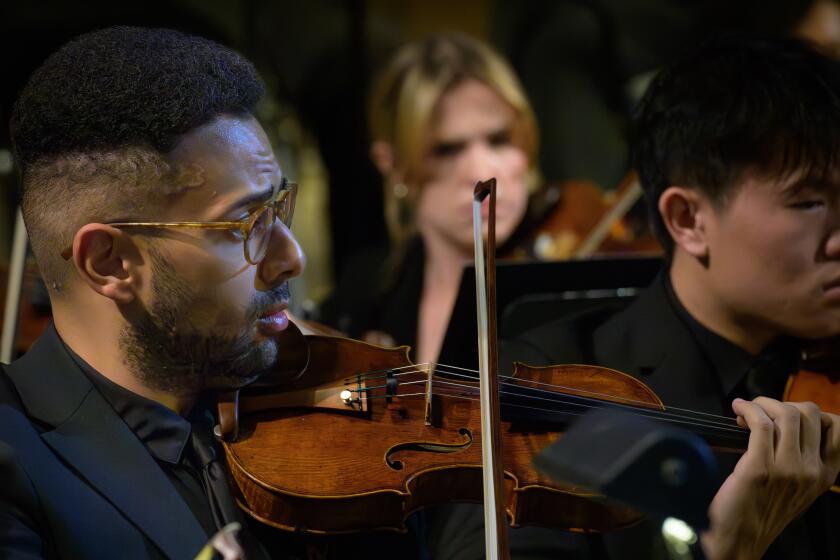Behind the Scenes : Construction: Even when the local season is over, the San Diego Opera’s set-building studio is still hard at work, making scenes for companies across the continent.
When the final curtain brought San Diego Opera’s “Die Zauberflote” production and the season to a close last month, most of the opera staff downshifted into a less hectic pace.
Except for one section.
The San Diego Opera Scenic Studio stepped up its pace. When its services are not needed by the company to either build a set or adapt an existing one, the scenic studio is in demand to build sets for opera and ballet companies across the country, not to mention its work for trade shows, posh theme parties and the occasional body-building competition.
Because only the largest U.S. opera companies maintain their own scene shops, there is plenty of work for the San Diego studio.
“The rest of the companies contract the construction of their new sets to a dozen or so scene-building operations across the country,” explained John David Peters, production carpenter. “Our main competition is Adirondack Scenic Shop in upstate New York and Dallas Stage Scenery in Texas.”
Over the last few years, prodded by San Diego Opera’s production director Gregory Hirsch, the local company’s scenic studio has moved from an operation that occasionally built sets to one that aggressively bids to construct sets for companies across the continent.
“When I came here in 1987, this operation was little more than a warehouse for props and old sets,” Hirsch said.
Over the last two seasons, the scenic shop has built sets for Lyric Opera of Chicago, Miami Opera, Houston Grand Opera and the Nevada Dance Theatre of Las Vegas.
The studio builds sets for the local company, although general director Ian Campbell is more likely to purchase a used set from another company to keep costs down. This season, the studio did the sets for the opera’s “La Boheme” and “Dialogues des Carmelites,” but most of its work is executed for other companies.
Last month, the scenic studio received the contract to build the set for “The Voyage of Edgar Allen Poe,” Dominick Argento’s new opera to be premiered this fall by Lyric Opera of Chicago.
“We have just 10 weeks to build it,” said production carpenter John David Peters. “We are best at this type of classical theater set--one with lots of art work and not overly mechanical. John Conklin’s design is pretty surreal, the sort of exaggerated, nightmarish qualities you might expect from an opera about Poe.” (Conklin is a noted U.S. set designer.)
This is the second contract the scenic studio has received from the noted Chicago company. Earlier this year, San Diego Opera mezzo-soprano Suzanna Guzman dropped the company a line from Switzerland, where she was performing in Rossini’s “Tancredi” with the Geneva Opera.
Peters and his crew built this “Tancredi” set last season for Lyric Opera of Chicago, and it was subsequently used by the Los Angeles Music Center Opera because the Rossini opera was a co-production with Chicago.
“Guzman wrote us that she was surprised to see the San Diego Opera Scenic Studio logo on the set for the ‘Tancredi’ production in which she was singing. Whenever we build a set that travels, it carries our name and gives us a certain status,” Hirsch noted.
The scenic studio occupies the better half of a long city block on Commercial Street in Logan Heights. Each section of the sprawling warehouse is devoted to a particular task: carpentry, painting, welding and assembly, not to mention the storage of every kind of prop imaginable.
Peters, who has worked for the scenic studio since he started on a San Diego Opera stage crew in 1969, takes particular pride in his projects.
“He stays with a set from the time it hits the paper until the curtain goes up on the completed set--he’s not just a builder in the shop,” said Hirsch. “He travels with a set to Miami or Chicago to make certain that what is assembled on stage is exactly what he supervised in our San Diego shop.”
“When you work on a set,” said Peters, “it’s like carrying a child and giving birth. If I can’t see the final project on stage, it would be like taking a child from its mother before she saw what it looked like.”
Because opera sets are costly--for a company like San Diego they range from $100,000 to $300,000 to design and construct--companies carefully store their sets in hopes they will be able to rent them and recoup some of their investment.
“It may be two years before our new ‘La Boheme’ set designed by John Conklin is rented by another company, although we’ve already had two inquiries since the January production,” Peters said.
Some sets turn out to have an unexpectedly long shelf life.
“When San Diego purchased its ‘Butterfly’ set second-hand in 1971,” said Hirsch, “they thought they would use it once and toss it. Fortunately they kept it, because it has been rented out eight or nine times, and even now is being used by Riverside Opera.”
Local critics may lament the frequent reappearance of this “Madama Butterfly” set at Civic Theatre, but it has more than returned its original investment to the company. Hirsch added that, when he wants to get rid of a set, he offers to sell it to a prospective company for a lower price than renting it.
According to master scenic artist Davis West, a veteran scene painter whose father plyed the same trade, opera sets have different requirements from typical theater sets.
“What is different about painting sets for opera is that you are not as confined; everything has to be bolder. Because of the size of opera houses, the stage is viewed from the greatest distances by the audience,” West explained.
Another challenge West and his crew face is the eccentricity of set designers.
“I recall working with Robert Israel on the set for Philip Glass’ ‘Akhnaten’ for Houston. Instead of giving me a color chip for the pyramids on the set, he reached in his pocket and pulled out a rock that he had found on a visit to Egypt. That was the precise color he wanted.”
But, no matter how eccentric the design requests may be, craftsmen such as West and Peters display an unmistakable professional pride in carrying them out. As with the stonemasons who worked on medieval cathedrals, their reward is not public recognition but the satisfaction of completing the vision.
More to Read
The biggest entertainment stories
Get our big stories about Hollywood, film, television, music, arts, culture and more right in your inbox as soon as they publish.
You may occasionally receive promotional content from the Los Angeles Times.






